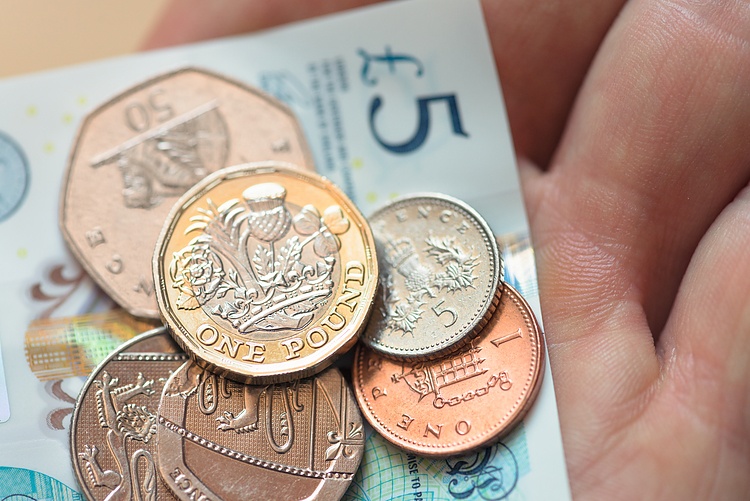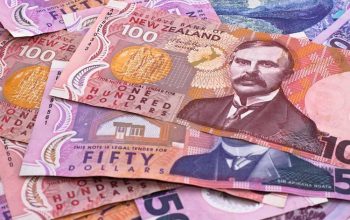- The Pound Sterling drops from 1.2680 as deepening Middle East tensions hurt risk-sensitive currencies.
- A sharp dip in UK inflation expectations improves BoE’s early rate cut hopes, weighing on the Sterling.
- The US Dollar bounces back ahead of the US Nonfarm Payrolls report.
The Pound Sterling (GBP) retreats to 1.2620 in Friday’s London session after failing to recapture the round-level resistance of 1.2700. The GBP/USD pair falls back as escalating geopolitical tensions and caution among market participants ahead of the United States Nonfarm Payrolls (NFP) report for March has boosted demand for the US Dollar.
Deepening uncertainty about when the Federal Reserve (Fed) will start reducing interest rates keeps investors on tenterhooks. On Thursday, Minneapolis Fed Bank President Neel Kashkari said rate cuts won’t be required this year if inflation stalls. Kashkari also said he forecasted two rate cuts for 2024 in the latest dot plot.
Meanwhile, easing inflation expectations in the United Kingdom has weighed on the Pound Sterling. The latest Bank of England (BoE) Decision Maker Panel (DMP) survey for February showed that most firms see selling prices and wage inflation cooling down over the next year. Selling price expectations decelerated to 4.1{721fc769be108e463fe4e33f629fb22fe291c423a7a69eaaf65dcb28e9b05dea} from 4.3{721fc769be108e463fe4e33f629fb22fe291c423a7a69eaaf65dcb28e9b05dea}, the lowest reading in over two years. Wage growth expectations softened to 4.9{721fc769be108e463fe4e33f629fb22fe291c423a7a69eaaf65dcb28e9b05dea} on a three-month moving average basis from 5.2{721fc769be108e463fe4e33f629fb22fe291c423a7a69eaaf65dcb28e9b05dea} in February.
Easing inflation expectations are expected to boost BoE rate cut expectations for the June meeting. Deepening hopes for BoE early rate cuts negatively influence the Pound Sterling.
Daily digest market movers: Pound Sterling falls while US Dollar stabilizes ahead of labor data
- The Pound Sterling extends its correction to 1.2620 on cautious market sentiment. Deepening Middle East tensions and uncertainty ahead of the release of the United States NFP report for March promoted recovery in the US Dollar.
- The US Dollar Index (DXY) bounces back from a two-week low of 103.90. The killing of seven members of Iran’s Islamic Revolutionary Guard Corps (IRGC) by air strikes from Israeli forces in Damascus has deepened fears of Iran’s direct involvement in the Israel-Palestine war.
- Going forward, the next move in the US Dollar will be guided by the US NFP report, which will be published at 12:30 GMT. US employers are expected to have recruited 200K workers, lower than the former reading of 275K. The Unemployment Rate is estimated to remain steady at 3.9{721fc769be108e463fe4e33f629fb22fe291c423a7a69eaaf65dcb28e9b05dea}. Investors will keenly focus on the Average Hourly Earnings data, which will provide a fresh inflation outlook. Annually, wage growth is expected to have softened to 4.1{721fc769be108e463fe4e33f629fb22fe291c423a7a69eaaf65dcb28e9b05dea} from 4.3{721fc769be108e463fe4e33f629fb22fe291c423a7a69eaaf65dcb28e9b05dea} in February.
- Strong labor demand and higher wage growth could allow the Federal Reserve to delay rate cut plans, while signs of labor market conditions easing will boost rate cut hopes for the June meeting.
- The Pound Sterling falls as investors hope that the Bank of England will pivot to rate cuts in June due to easing price pressures. Expectations for the BoE to reduce rates from June were reinforced after BoE Governor Andrew Baily said that market expectations for two or three rate cuts this year are reasonable.
- Meanwhile, the United Kingdom’s soft Services PMI data for March, released on Thursday, has impacted the economic outlook. The Services PMI fell to 53.1, missing expectations and the prior reading of 53.4. Tim Moore, Economics Director at S&P Global Market Intelligence, said: “The recovery in service sector output lost a little bit of momentum during March, and more so than suggested by the flash PMI results, but the overall picture remains reasonably positive.”
Technical Analysis: Pound Sterling finds selling pressure near 1.2680
The Pound Sterling falls further after retreating from its two-week high of 1.2680. The GBP/USD pair fails to sustain above the 20-day and 50-day Exponential Moving Averages (EMAs), which trade around 1.2660. Meanwhile, the 200-day EMA at 1.2566 continues to provide support.
On a broader time frame, the horizontal support from December 8 low at 1.2500 would provide further cushion to the Pound Sterling. Meanwhile, the upside is expected to remain limited near an eight-month high of around 1.2900.
The 14-period Relative Strength Index (RSI) rebounds above 40.00 after slipping below it. This should not be considered as a “bullish reversal” until it decisively breaks above 60.00.
Pound Sterling FAQs
The Pound Sterling (GBP) is the oldest currency in the world (886 AD) and the official currency of the United Kingdom. It is the fourth most traded unit for foreign exchange (FX) in the world, accounting for 12{721fc769be108e463fe4e33f629fb22fe291c423a7a69eaaf65dcb28e9b05dea} of all transactions, averaging $630 billion a day, according to 2022 data. Its key trading pairs are GBP/USD, aka ‘Cable’, which accounts for 11{721fc769be108e463fe4e33f629fb22fe291c423a7a69eaaf65dcb28e9b05dea} of FX, GBP/JPY, or the ‘Dragon’ as it is known by traders (3{721fc769be108e463fe4e33f629fb22fe291c423a7a69eaaf65dcb28e9b05dea}), and EUR/GBP (2{721fc769be108e463fe4e33f629fb22fe291c423a7a69eaaf65dcb28e9b05dea}). The Pound Sterling is issued by the Bank of England (BoE).
The single most important factor influencing the value of the Pound Sterling is monetary policy decided by the Bank of England. The BoE bases its decisions on whether it has achieved its primary goal of “price stability” – a steady inflation rate of around 2{721fc769be108e463fe4e33f629fb22fe291c423a7a69eaaf65dcb28e9b05dea}. Its primary tool for achieving this is the adjustment of interest rates. When inflation is too high, the BoE will try to rein it in by raising interest rates, making it more expensive for people and businesses to access credit. This is generally positive for GBP, as higher interest rates make the UK a more attractive place for global investors to park their money. When inflation falls too low it is a sign economic growth is slowing. In this scenario, the BoE will consider lowering interest rates to cheapen credit so businesses will borrow more to invest in growth-generating projects.
Data releases gauge the health of the economy and can impact the value of the Pound Sterling. Indicators such as GDP, Manufacturing and Services PMIs, and employment can all influence the direction of the GBP. A strong economy is good for Sterling. Not only does it attract more foreign investment but it may encourage the BoE to put up interest rates, which will directly strengthen GBP. Otherwise, if economic data is weak, the Pound Sterling is likely to fall.
Another significant data release for the Pound Sterling is the Trade Balance. This indicator measures the difference between what a country earns from its exports and what it spends on imports over a given period. If a country produces highly sought-after exports, its currency will benefit purely from the extra demand created from foreign buyers seeking to purchase these goods. Therefore, a positive net Trade Balance strengthens a currency and vice versa for a negative balance.



